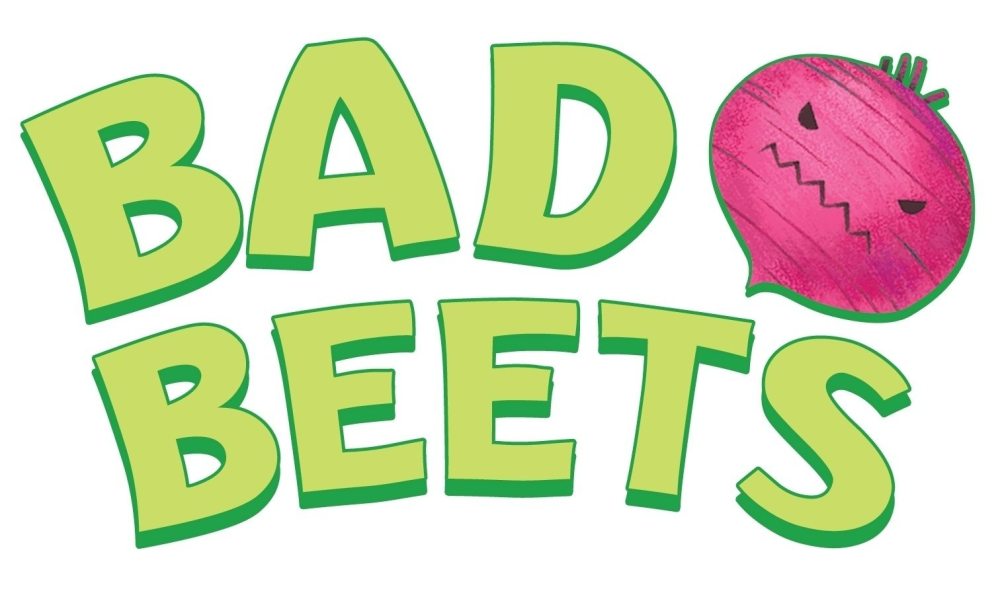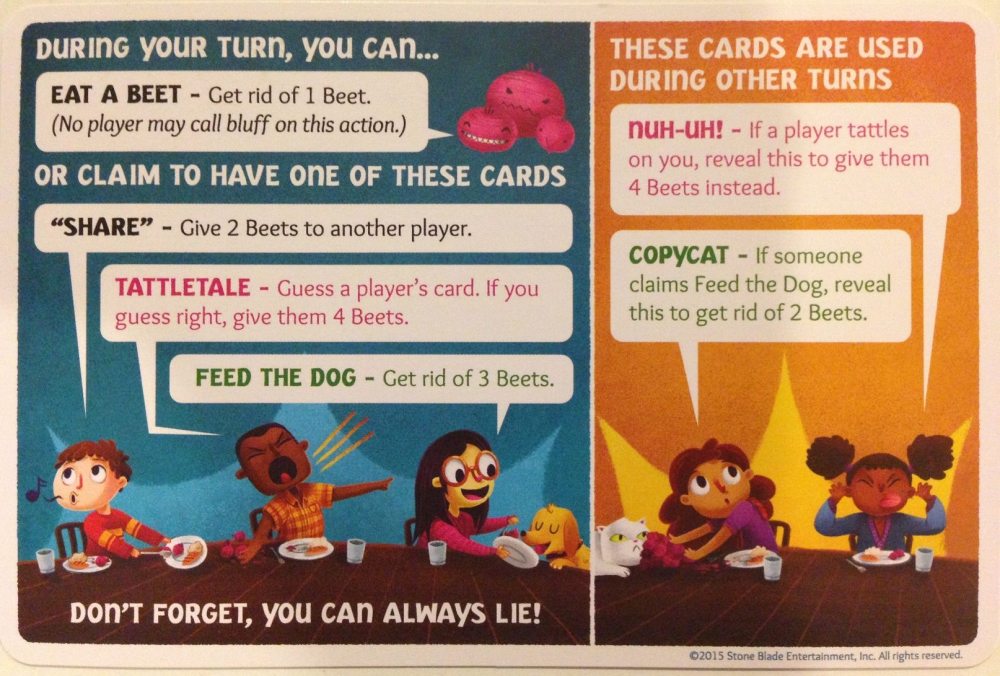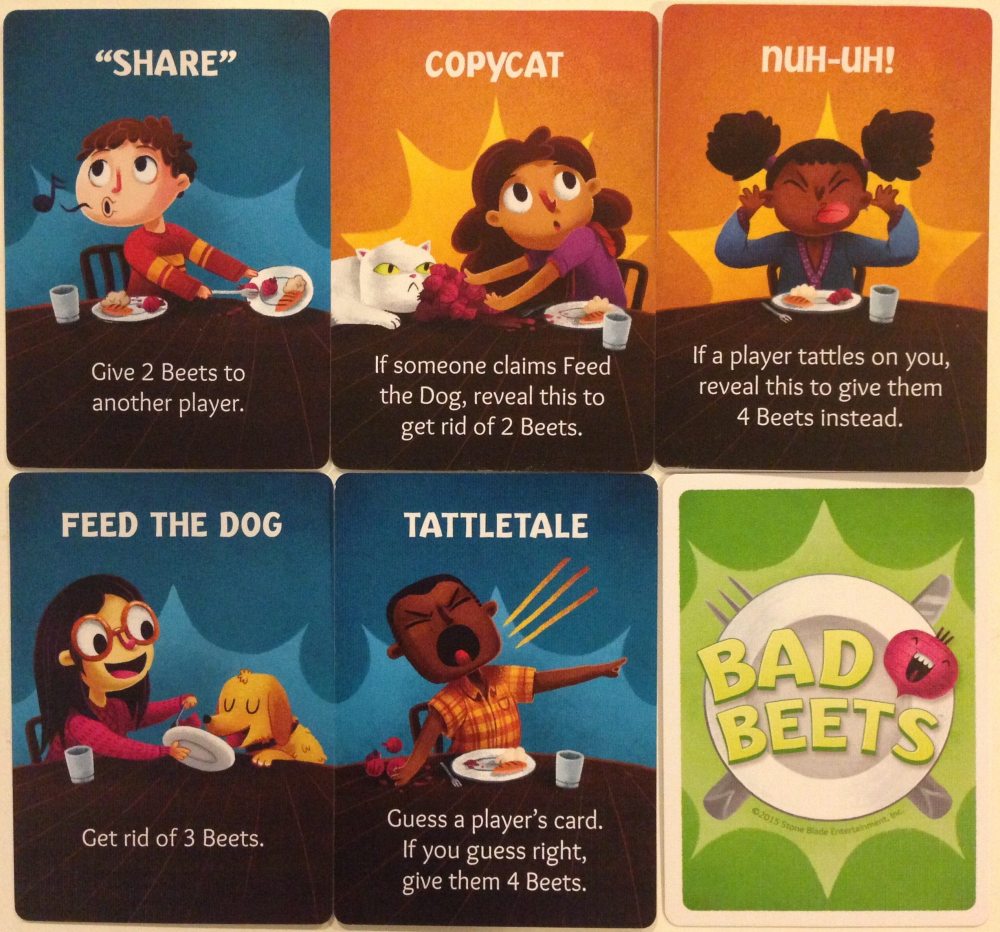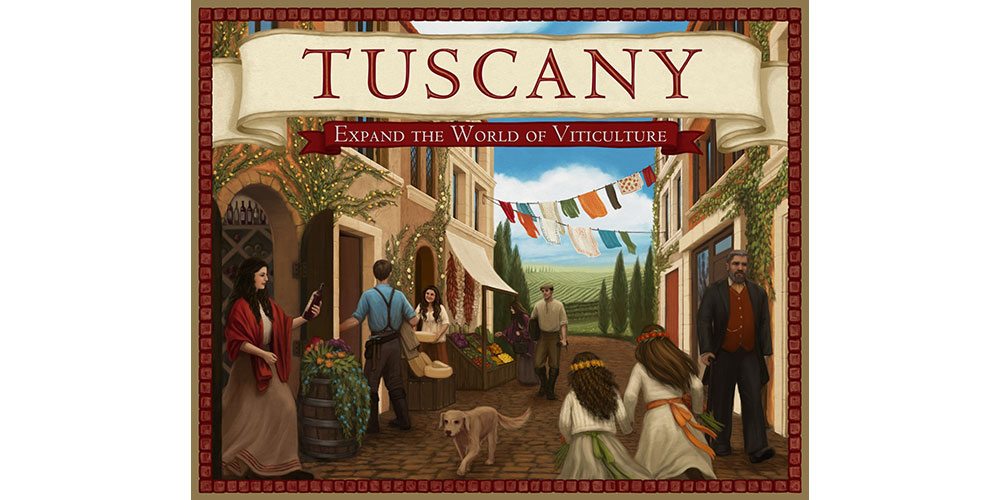Bad Beets is a small game that made a surprising splash at this year’s Gen Con. That’s not a knock against the game; it is small – in both physical size and gameplay. Published by Stone Blade Entertainment, the game is decidedly different than their other “big” game: Ascension.
Summary
Bad Beets is a family-friendly, fast-paced bluffing card game. Why the name? Well, the entire concept is that you’re trying to get rid of your beets as fast as you can. Because who likes beets, amirite? You can force them on the poor, unsuspecting dog. You can “share” them with another player. Or you can… GASP… eat them! But be careful, because if you try to get rid of your beets by bluffing about the card in your hand… then you’ll end up with MORE beets. Ick.
For such a small, relatively simple game, it has a rather nice production value. Included in the box are:
- 15 role cards (representing 5 possible actions)
- 50 beet tokens
- 15 ice cream tokens
- 5 action reminder cards
- 1 rulebook
The cards are a decent-quality linen stock, and though they won’t hold up to years of abuse, this is hardly an heirloom game that will be passed down through the generations. Take care of the cards, and they’ll do just fine.
Setup and Gameplay
Setup is super easy. Every player gets dealt one card (face down), 8 beets, and an action reminder card. The rest of the beets can be placed to the side or back in the box (you may never need them), and the rest of the cards stay face down to form a draw deck. That’s it.
At the beginning of a game, the first player draws a card from the deck and chooses one card to keep (between that card and the one dealt during setup). The card not chosen is then passed (face down) to the player on the left, where it stays until his or her turn.
At this point, the player can choose to take one of four possible actions.
- Eat a beet: get rid of 1 beet token
- Feed the dog: get rid of 3 beet tokens
- Tattletale: guess another player’s card; if you guess correctly, give him or her 4 beet tokens
- “Share”: give 2 beet tokens to another player
This is where the bluffing aspect comes into play. As the active player, my goal is to get rid of as many beets as possible. I also have to convince the other players that the action I’m taking matches up with the card in my hand. Therefore, if I choose to feed the dog and get rid of 3 beet tokens, I either have the Feed the Dog card in my hand or I’m bluffing that I do.
Before I actually get rid of my beets, all of the other players have a chance to react. Their options include:
- Do nothing: The active player can do the announced action, unchallenged.
- Nuh-uh!: If the active player tries to guess your card with Tattletale, you can reveal this card to give him or her 4 beets instead of the other way around.
- Copycat: If the active player chooses to feed the dog, you can reveal this card to get rid of 2 of your own beet tokens.
- Call a bluff: Whenever the active player performs an action (except for eating a beet, which cannot be called into question), any other player can call his or her bluff.
When a bluff is called, the active player must reveal his or her card, discard it, and draw a new one. If the card is different from the action that was announced, the action doesn’t happen, and the player who called the bluff correctly gets rid of 1 beet. If the card matches the action that was announced (i.e., the active player wasn’t bluffing), then the player who called the bluff incorrectly gains 1 beet.
It’s important to note that, as the active player, if no one calls my bluff, I do not reveal the card in my hand. It stays in my hand until my next turn, when I choose to keep either that card or the one passed to me by another player.
Play continues in this manner. The only difference is that other players will begin their turns by picking up the card that was passed to them from the previous player (rather than from the deck).
The first player to get rid of all of their beet tokens wins!
What about those ice cream tokens, you ask? Well, they’re for longer sessions of the game. The winner of each game earns an ice cream token, and the first to collect 3 wins the match.
Verdict
For a 15-minute light filler game, Bad Beets is surprisingly fun. Play is indeed quick, and the bluffing adds a fun aspect that invariably lightens the mood. The box recommends the game for ages 8+ but, realistically, if your kids can read, they can play. My 6-year-old picked it up and was able to play just fine.
It’s also designed for 2-5 players, but it really doesn’t play well with 2 at all. Because players begin each turn by passing an unwanted card to another player, you’re constantly passing cards back and forth to each other in a 2-player game. Usually, it ends up being the same card, and there’s really no mystery as to what the other player has in his or her hand. That negates the bluffing aspect of the game… and takes away a lot of the fun, obviously.
With 3-5 players, Bad Beets can really shine as a lighthearted, laugh-filled segue between heavier games. It’s also a perfect candidate for family game night.
I mean, come on, kids hate vegetables and they love to lie, right? No? Just mine? Okay, moving on.
Bad Beets has no ambition to be more than what it is. It doesn’t have delusions of grandeur, and the creators understand that this is targeting an entirely different market than something like Ascension. Keeping all of that in mind, it’s great fun. Add it to the shelf and break it out when you have about 15 minutes of downtime. Definitely recommended.
(Disclosure: GeekDad received a review copy of this game. All opinions remain my own.)









